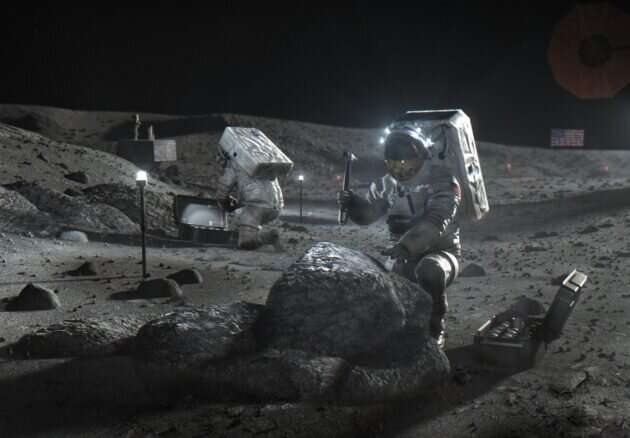This article has been reviewed according to Science X's editorial process and policies. Editors have highlighted the following attributes while ensuring the content's credibility:
fact-checked
peer-reviewed publication
trusted source
proofread
The moon may be the best place to transport rocket fuel

When astronauts return to the moon in the next few years, the plan is to have them stay for good while establishing a permanent outpost on Earth's nearest celestial neighbor. Like all space missions, a lunar outpost will require fuel for long-term sustainability, but would it be better to mine fuel on the moon or get fuel resupply from the Earth? This is what a team of researchers led by Bocconi University in Italy hope to address as they addressed the best option in terms of deriving fuel from either the Earth or the moon.
Mattia Pianorsi, who is a junior researcher of the Space Economy Laboratory at the SDA Boccini School of Management and a Ph.D. Candidate at the University of St. Gallen, recently told Universe Today the main objective of the study was to ascertain the economic and technical feasibility of mining fuel from the moon's water ice deposits or from the Earth.
Both options would use an orbiting depot (OD) which Pianorsi says would be used "as a distribution channel for satellites as well as rockets in space." The OD, which is separate from NASA's proposed Lunar Gateway and is also not mentioned in the study, would possess a maximum fuel capacity of 25 tons and be located at the Earth-moon Lagrange Point L1 which is approximately three-quarters the distance between the Earth and the moon.
For the study, the researchers conducted a Monte Carlo analysis to evaluate the risks associated with both options. For their scenario, the researchers used hypothetical variables such as a lunar mining company, a transporter/distributor company, and end-users.
The hypothetical lunar mining company charges fuel at $500 per kilogram while for the Earth refueling option a transporter purchases the fuel from the Earth at a negligible cost. Both options considered fixed costs, including Design, Development, Testing, and Evaluation (DDT&E), Manufacturing, and Transportation, while the recurring costs included Refueling and Operations.
The researchers determined the Earth refueling option would involve approximately 1.5 launches of a Falcon Heavy (FH) Expendable plus propellant tank with a spacecraft refueling payload of 17.5 tons. While the OD has a capacity of 25 tons, the FH would need to bring a combined total of 26.69 tons as the remaining 1.69 tons of fuel would be used to "transfer the refilling tank with its subsystems," according to the study.
As stated, the fuel costs are negligible, but the launch costs are estimated to be $150 million per launch, putting a total refueling price tag at $227.9 million, which includes launch plus fuel costs. The estimated launch costs also totaled $6511.4 per kilogram with a total operation cost of $42.38 million per year.
For the moon refueling option, the researchers used a hypothetical moon shuttle built by the Cislunar Space Development Company (CSDC) with a payload of 25 tons that launches from the moon, docks and refuels the OD to its maximum capacity of 25 tons , then returns to the lunar surface, with the assumption that zero fuel is lost during the entire process.
As stated, the hypothetical lunar mining company put the fuel costs at $500 per kilogram, and the study put the total refueling price tag at $37.51 million dollars, which includes launch plus fuel costs, giving a total operation cost of $35 million per year.
Based on these results, the researchers concluded that refueling the OD is more affordable from the moon than from the Earth.
"So, if you want to put this project into real substance, it should be able to understand and to analyze data from a project financing point of view," Pianorsi recently told Universe Today.
"So it's the same logic under which you finance the infrastructure here on Earth, you have to understand how to incentivize your investors to jump in on the basis of the mitigation of the risk that you that you put in place, for instance, through contracts. So, this is a very important thing to do if you want to develop infrastructure, involving not only the public money, and maybe the money of the corporates, but even the money of financial investors. And I don't speak about venture capital or private equity, I speak about institutional investors," Pianorsi tells Universe Today that he believes these factors should be the next steps in terms of research.
As for the upcoming Artemis missions, Pianorsi emphasized to Universe Today the importance of "creating an economic cycle between the Earth and the moon" but also emphasized the importance of not just having space agencies and space companies conducting lunar and Mars activities, but non-space companies, as well.
"The companies need to understand that economic sustainability is the new prerogative of the new space economy," Pianorsi tells Universe Today. "It's not anymore cost-plus contracts of NASA. Right now, the times are changing and even space agencies, especially in times of budget constraints, need to rely on private companies to make innovation and to improve efficiency. And this implies not only from a cost perspective, but even from a market perspective."
The research is published in the journal Acta Astronautica.
More information: Andrea Sommariva et al, Preliminary analyses on technical and economic viability of moon-mined propellant for on-orbit refueling, Acta Astronautica (2023). DOI: 10.1016/j.actaastro.2023.01.004
Journal information: Acta Astronautica
Provided by Universe Today





















